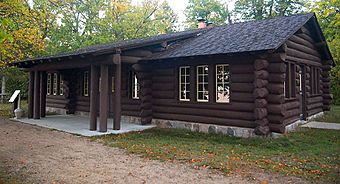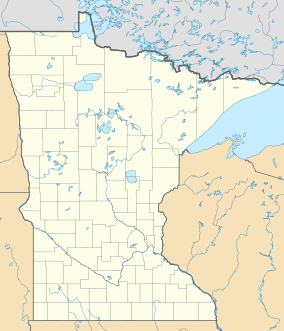Lake Bemidji State Park facts for kids
Quick facts for kids Lake Bemidji State Park |
|
|---|---|

An open-water bog in the north half of Lake Bemidji State Park
|
|
| Location | Beltrami, Minnesota, United States |
| Area | 1,654 acres (6.69 km2) |
| Elevation | 1,348 ft (411 m) |
| Established | 1923 |
| Named for | Lake Bemidji |
| Governing body | Minnesota Department of Natural Resources |
|
Lake Bemidji State Park CCC/NYA/Rustic Style Historic Resources
|
|

The Shelter Building from the southeast
|
|
| Location | Off County Highway 20, Northern Township |
|---|---|
| Nearest city | Bemidji, Minnesota |
| Area | 8 acres (3.2 ha) |
| Built | 1937–9 |
| Architect | State of Minnesota, National Youth Administration |
| Architectural style | National Park Service rustic |
| MPS | Minnesota State Park CCC/WPA/Rustic Style MPS |
| NRHP reference No. | 89001674 |
| Added to NRHP | October 25, 1989 |
Lake Bemidji State Park is a cool place in Minnesota, United States. It sits right on the north side of Lake Bemidji, a big lake about 6,765 acres (27.4 km²) in size. The northern part of the park has a special kind of wetland called a spruce-tamarack bog. You can also see old buildings here. They were built in the 1930s by groups like the Civilian Conservation Corps (CCC). These buildings are now listed as important historic places. The park is just 5 miles (8 km) north of Bemidji city.
Contents
Park Landscape and How it Formed
The land you see in the park today was shaped by huge glaciers. About 10,000 years ago, these giant ice sheets melted. As they melted, they left behind soil, gravel, and rocks. This created the rolling hills and dips you see in the park.
Many swamps and bogs formed when big chunks of ice broke off the melting glaciers. These ice chunks left holes in the ground that later filled with water. Lake Bemidji itself was formed by two huge blocks of ice left behind by the melting glacier. The land is still slowly changing today. Wind, water, and waves on the lake continue to shape the park's landscape.
Park History
For hundreds of years, the ancestors of the Dakota people lived around Lake Bemidji. They fished and hunted here. Around 1750, the Anishinaabe people settled in the area. The Anishinaabe called the lake "Bemiji-gau-maug." This name meant "cutting sideways through" or diagonally. It described how the Mississippi River flows through the lake. Later, Europeans found the Anishinaabe name hard to say. So, they just called it "Bemidji."
In the late 1800s, people from Europe came to this area. They wanted to cut down the tall white and Norway pine trees. During the busiest time of logging, a lumber mill on the south shore of Lake Bemidji was very important. It was a major center for logging in the whole country. When the government bought the land for the park, some areas still had their original, untouched forests. In 1923, the Minnesota State Legislature set aside 421 acres (1.7 km²) to create Lake Bemidji State Park. Today, the park has grown to over 1,600 acres (6.5 km²). More than 150,000 visitors come to enjoy it each year.
Amazing Wildlife
The many different plants in the park help support lots of animal species. Birdwatching is a very popular activity here. If you go camping, you might hear the sounds of red-eyed and warbling vireos. You could also hear rose-breasted grosbeaks and many other songbirds. Near the lake, you might spot loons, eagles, herons, gulls, and even osprey.
If you hike on one of the park's trails, you might see a doe with her fawn. You could also spot a North American porcupine eating high up in a Jack pine tree. Sometimes, you might even see an black bear! Eastern chipmunks and red squirrels are also common in the park's visitor areas.
In the wet parts of the park, you can find waterfowl, beavers, muskrats, and mink. In the evening, the park fills with the sounds of gray treefrogs, spring peepers, and chorus and wood frogs. The hoot of a barred owl, the flute-like song of the veery, and the tapping of a sapsucker add to the wild sounds.
Overall, nearly 50 types of mammals and almost 200 different kinds of birds live in Lake Bemidji State Park. You can ask the park naturalist for the latest information. They can tell you where and when to see the park's amazing wildlife.
Fun Activities and Recreation
Lake Bemidji State Park offers fun things to do all year long! You can go camping, hiking, or biking. In winter, you can try cross-country skiing, snowmobiling, or snowshoeing. The park also has places for picnics, swimming, and volleyball. You can go fishing and boating, and join special nature programs.
Camping Adventures
The park has 95 places where you can drive in your car to camp.
- 43 of these sites have electricity.
- 4 are pull-through sites, which are easy for bigger vehicles.
- 4 sites are made for people with disabilities.
In winter, only one drive-in site is open, and it does not have electricity. Other sites are available for walk-in campers after a lot of snow has fallen.
There are also two group campsites:
- Bass Creek is for tents only and can fit up to 30 people. Water is available nearby.
- North Group Camp can fit up to 50 people. It has three spots for small trailers or pickup campers.
Both group camps are open in winter, but you have to walk to them. To book a group camp, call the state park reservation service at 1-866-85PARKS or visit their website at www.stayatmnparks.com.
Trails to Explore
In the summer, there are many trails for you to enjoy:
- 2 miles (3.2 km) of trails are easy to use for everyone, including the boardwalk and Rocky Point trail.
- 15 miles (24 km) of hiking trails range from easy to medium difficulty. These trails take you through forests of pine, aspen, and hardwood trees.
- 6 miles (9.7 km) of paved bike trails connect to the Paul Bunyan state trail.
- 5 miles (8 km) of mountain bike trails are available.
- There's a 1/4 mile (0.4 km) Bogwalk, which you can reach after a 1 mile (1.6 km) hike.
The Bemidji Blue Ox Marathon race, which started in 2013, runs through the park on its paved trails.
In the winter, the park offers:
- 11 miles (18 km) of groomed cross-country ski trails.
- 3 miles (4.8 km) of snowmobile trails that connect to a larger trail system outside the park.
- You can snowshoe anywhere in the park, except on the groomed trails. You can rent snowshoes at the park office.
Park Facilities
In the summer, visitors can use the picnic and beach area by the lake. This area has picnic tables, a covered shelter with a fireplace, and a volleyball court. There are also showers, restrooms, and grills for cooking. The shelter building and the sanitation building in the park were built by the Civilian Conservation Corps and the National Youth Administration. They are made in a rustic log style and are now listed as historic places. You can reserve the shelter by calling the park office.
There is a boat landing next to the picnic area if you want to go fishing or boating. You can rent canoes and fishing boats from May 10th to October 13th. There is also a fishing pier that is easy for everyone to use.
In the winter, you can rent snowshoes at the park office. Or, you can park in the picnic area parking lot, bring your own ice fishing gear, and walk onto the lake to fish. There is a warm building called the Trail Center in the park's Visitor Center.
Naturalist Programs
The Visitor Center is open all year. Here, you can find information about the park's trails, animals, geology, and other cool features. They have exhibits, films, and slide shows. You can ask for a full list of programs and special events for groups.
Naturalist programs are offered from mid-June through Labor Day, Wednesday through Sunday. In the fall, winter, and spring, programs are usually on weekends. The Interpretive Center can also open for schools, scouts, and other groups if you ask. These programs often teach about the lake and wetland environments in the park.
Summer programs include morning hikes, boat tours of Lake Bemidji, evening films, and campfire talks. Winter programs include snowshoeing, candlelight skiing, and animal tracking. The Visitor Center is open daily. It's a great place to gather for programs and share experiences by the warm woodstove.
Images for kids





